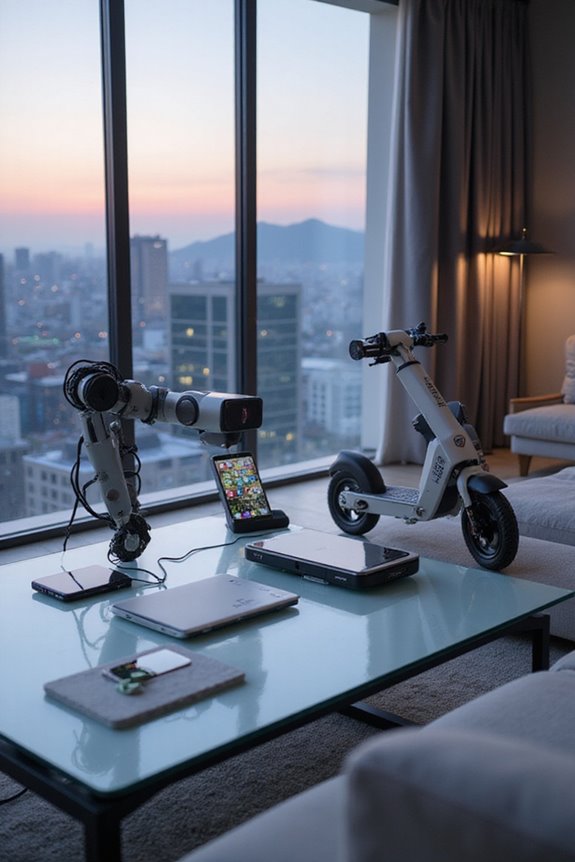In South Korea, electronics innovation is driven by major companies such as Samsung and LG, which focus on advanced display technologies like OLED and MicroLED. Additionally, Samsung leads breakthroughs in semiconductor solutions and AI memory technology. Our robotics sector thrives too, with firms like Rainbow Robotics innovating in humanoid designs. Significant government investments bolster these industries, supporting both established players and startups. We can further explore emerging trends and developments that shape the electronics landscape.
Key Takeaways
- Samsung’s OLED and MicroLED displays are leaders in innovative visual technology, enhancing video quality with AI-powered systems.
- Samsung’s C-Lab Innovations showcase diverse startups, contributing to global tech advancements, with multiple CES Innovation Awards.
- The autonomous mobility technologies funded by South Korea are pushing the boundaries in robotics and innovative transportation solutions.
- Breakthroughs in AI memory solutions by Samsung Electronics and SK hynix are revolutionizing the semiconductor industry.
- Wearable devices from Korean companies are enhancing health monitoring by providing real-time biometric data through innovative technology integration.
South Korea: A Global Innovation Champion
As we examine South Korea’s emergence as a global innovation champion, it becomes clear that the country’s strategic investment in technology is driving significant economic transformation. With government initiatives like the “Korean New Deal,” South Korea has allocated around USD 160 billion towards digital technologies, including AI and IoT. This commitment fuels the rise of Korean startups, essential players in the digital transformation landscape, as they contribute innovative solutions across multiple sectors. We’re witnessing a robust growth trajectory, with the Industry 4.0 market expected to reach USD 28.11 billion by 2033. Additionally, advancements in automation and smart factories are projected to reshape manufacturing, increasing overall productivity while marking Korea’s leadership in global tech innovation.
Highlights From Samsung’s C-Lab Innovations

Samsung’s C-Lab Innovations showcase the company’s commitment to fostering a diverse range of groundbreaking startups, contributing substantially to the global technology landscape. At CES 2025, we witnessed the impressive contributions of C Lab startups, with 15 projects showcased. Among these, Pinpoint, an IoT-based building management system, won a CES Innovation Award in the Smart Cities category for its innovative features. Other notable innovations included Quester, recognized in XR technology, and GhostPass, which excelled in security and fintech solutions. Collectively, C-Lab startups secured 12 Innovation Awards, further affirming Samsung’s role as a launchpad for innovation. This structured support not only strengthens Korea’s startup ecosystem but also amplifies its global recognition in technology advancements.
Breakthroughs in the Semiconductor Industry
Given the rapid advancements occurring within the semiconductor industry, South Korea has firmly established itself as a central player on the global stage. Key companies like Samsung Electronics and SK hynix are pioneering breakthroughs in memory technology, focusing on AI memory solutions that cater to growing demands for high-speed and energy-efficient data processing. At SEMICON Korea 2025, these innovations were prominently showcased, emphasizing the importance of semiconductor collaboration. The industry’s shift towards integrated manufacturing paradigms highlights the need for interdependent design, interconnects, and packaging processes. This collaborative model fosters partnerships across various sectors, fueling faster innovation cycles that support the development of next-generation semiconductor applications. Ultimately, these efforts position South Korea as a leader in the semiconductor market.
Robotics and Mobility Innovations Overview

In light of the significant investments and advancements in robotics and mobility, South Korea is positioning itself as a leader in these fields. The government has allocated approximately US$349 million specifically for AI projects, focusing on both industrial robotics and autonomous mobility solutions. Companies like Rainbow Robotics are at the forefront, innovating with humanoid robotics such as the Mecanum Wheel System for enhanced maneuverability. Additionally, the development of self-driving vehicles receives significant support, with US$87.6 million directed toward advancing autonomous mobility technologies. Events like ROBOTWORLD 2025 gather industry leaders to showcase the latest in robotics and AI, emphasizing collaboration and the future of smart manufacturing. Together, these efforts underline Korea’s commitment to advancing robotics and mobility innovation.
Advancements in Display and Digital Health Technologies

As we explore the advancements in display and digital health technologies, it’s important to recognize how these innovations intertwine with the prior discussions on robotics and mobility. Samsung Display and LG Display lead the world in OLED and MicroLED technology, ensuring display enhancements with flexible, high-resolution screens for various applications. AI-powered systems now upscale video quality, increasing detail and reducing motion blur considerably. In health technologies, advancements include wearable devices that provide real-time biometric data, enhancing health monitoring. Telemedicine platforms utilize high-resolution displays for secure patient interactions. Moreover, integrating AI for diagnostics allows for quicker and more accurate medical imaging. Collectively, these innovations work towards better health outcomes and immersive visual experiences, shaping the future of technology in our lives.
Government Investment Impact on Industrial AI Innovation
While examining the role of government investment in driving industrial AI innovation, it becomes clear that strategic financial commitments are essential for enhancing technological capabilities. South Korea’s plans to invest approximately $2.9 billion by 2030 in a national AI computing center demonstrate a focused effort to advance AI infrastructure. Additionally, the government’s increase in AI-related research and development funding from 900 billion to 1.1 trillion won underscores its commitment to bolster the sector. Significantly, over 80% of the supplementary AI budget in 2025 will be allocated to acquiring 10,000 high-performance GPUs, enabling enhanced domestic capabilities. Such government funding initiatives are pivotal for supporting the integration of AI in manufacturing, agriculture, and security, fostering a robust industrial AI ecosystem.
Frequently Asked Questions
What Are the Criteria for Judging Innovation in Korean Electronics?
When we judge innovation in Korean electronics, we consider innovation metrics such as R&D intensity and user satisfaction, alongside technological advancements like semiconductors and IoT, to assess overall market success and consumer impact.
How Do Korean Startups Gain Support in the Electronics Sector?
Isn’t it fascinating how Korean startups thrive in electronics? They gain support through generous government funding and dedicated startup incubators, ensuring innovation flows freely and helping them turn groundbreaking ideas into reality.
What Market Trends Are Driving Innovation in Korean Electronics?
We’ve noticed that market dynamics and technological advancements greatly drive innovation in Korean electronics. Consumer demand for multifunctional devices alongside emerging technologies like AI and printed electronics keeps pushing manufacturers to create cutting-edge solutions for our needs.
How Does Consumer Feedback Influence Korean Electronics Innovation?
We’re listening to consumer preferences, understanding feedback loops, and engaging directly with users. By adapting quickly, we enhance our products, ensuring they not only meet needs but also exceed expectations in the ever-evolving electronics landscape.
What Is the Role of Sustainability in Korean Electronics Development?
Sustainability’s role in Korean electronics development is essential; we’re embracing sustainable materials and eco-friendly practices. By prioritizing these initiatives, we not only reduce our environmental impact but also meet consumer demand for greener products.





